RESEARCH ARTICLE
Characterization of the High Swelling Green Clay in the Vicinity of Amman Area
Monther Abdel Hadi1, Ibrahim Khliefat2, *, Nafeth Abdelhadi3, Nidhal Saada4
Article Information
Identifiers and Pagination:
Year: 2021Volume: 15
First Page: 360
Last Page: 369
Publisher ID: TOCIEJ-15-360
DOI: 10.2174/1874149502115010360
Article History:
Received Date: 5/3/2021Revision Received Date: 14/7/2021
Acceptance Date: 10/8/2021
Electronic publication date: 16/12/2021
Collection year: 2021

open-access license: This is an open access article distributed under the terms of the Creative Commons Attribution 4.0 International Public License (CC-BY 4.0), a copy of which is available at: https://creativecommons.org/licenses/by/4.0/legalcode. This license permits unrestricted use, distribution, and reproduction in any medium, provided the original author and source are credited.
Abstract
Introduction:
Jordan is awarded huge areas in the north and western part of the country in which brown and green clay is dominant. This research focuses on the problems and behaviour of the green clay only. The main problem of the green clay is its high swelling pressure which is the main cause of excessive settlement and wall cracks in buildings, especially during the wet season.
Methods:
This study aims to investigate the engineering properties and behaviour of the green clay deposits in the Amman area, which will serve as a guide for both geotechnical and structural engineers when preparing the foundation design.
Results:
Based on the consolidation test, the investigated green clay showed high swelling pressure of 3.11 kg/cm2, liquid limit (LL) of 73%, plasticity index (PI) of 40%, the shrinkage limit (SL) of 12%, and liquidity index (LI) of 0.125. The moisture content at saturation is 35.14%, while the natural moisture content is 28%, dry density is 1407 kg/m3, cohesion (C) is 0.20 kg/cm2 and unconfined compressive strength is 1.05 kg/cm2. The XRD results of the clay size fraction have confirmed the presence of the expansive clay mineral smectite as the essential clay mineral together with kaolinite. Results provide a general understanding of the behaviour and properties of the green clay, and the regression analysis showed good correlations between the liquid limit and initial moisture content with the compression index and also between the initial void ratios with the swelling index.
Conclusion:
Changes in the volume are due to the unsaturation level of clay when provided with initial water content.
1. INTRODUCTION
Clay is recognized as an essential material for geotechnical engineering, given its increasing use in engineering practices [1, 2]. However, various changes are to be made before its integration in the engineering projects, given its low strength, increased compressibility, and volumetric changes [2]. All clays are plastic soils with different degrees, but not all clays show a swelling character; this is related to expansive clay minerals content and fabric [3]. The plasticity of clays is related to their sheet-like fabric, while the swelling potential is related to clay structure and the interlayer cation, mainly Ca, Na, or K. Mineralogy of clay minerals and their influence on engineering properties of soils were discussed by Mitchell and Soga [4]. The swell potential of expansive clays was defined as the percent increase of vertical increase of height of a laterally confined soil [5]. Damage costs caused by expansive soils have been reported to cost more than all other natural hazards combined, including earthquakes, fires, floods, and tornadoes [6]. Many of the constructed roads revealed severe distress as alligator cracks and potholes shortly after construction. Concrete structures suffered settlement cracks due to successive differential settlements in rainy seasons and shrinkage during dry seasons where moisture content variation takes place in such clays. Georgiannou [7] has investigated the effect of the presence of sand in clay and reported that the presence of fine sand has a remarkable effect on the stress-strain behaviour of the soil. Terzaghi and Peck [8] also concluded that both permeability, (k), and volume compressibility (mv) decrease with the decrease of void ratio.
Several studies have also emphasized the improvement of the soil characteristics before its use in construction projects, more precisely, in roads, dams, slurry walls, waste landfills as well as airports. Awawdeh, El-Mughrabi, and Atallah [9] reasons negligence towards it can lead to an increased loss in terms of economic, infrastructural, and human lives. Arnous [10] shows that the characterization of the clay minerals helps in reducing the detrimental natural hazards and lowering the probability of landslides. Earlier research of Al-Homoud, Khoury, and Al-Omari [11] showed that smectites have high swelling potential, consolidated and weak shear strength, which adversely affects the structure, including dams, bridges, building foundations, railway, and more. Similar is the case for Jordan, which observed huge loss due to increased land sliding [9].
High swelling green clay layers, lenses, or cavity filling appear at variable locations and depths in the vicinity of the Amman area in Jordan. In many locations, this type of problematic soil appears in variable thickness strata intercalated with thin marly limestone, marlstone, marl, and phosphatic layers. Green clays or smectites are characterized by their high sensitivity to moisture content variation, which plays an important role in strength, swell, and shrinkage behaviour [12]. These deposits belong to the upper part of the Cretaceous age and appear at very shallow depths in many locations as subgrade for construction facilities and foundations for various concrete structures.
Clay is plate-like particles <2 μm in diameter and is formed mainly of clay minerals [13]. The high chromium content and Si/Al ratio indicate that the clay from the Suweileh area is Cr-rich smectite [14]. Expansive clays show a very high potential for volume change [15]. The presence of sand and silt in clay usually affects the compression path [16]. Consistency limits or Atterberg's limits, which are the moisture content at which the consistency of clayey soil is changed from the solid to semi-solid, plastic, and liquid state, are used as simple means to estimate swell and shrinkage potential.
However, the work that has been performed on clays has neglected green clay properties, particularly for the area between the east north, the University of Jordan, and the Al-Urdun highway. Previous work on the clays in Jordan has been carried out in the Suweileh area [14]; it has only studied the origin and smectites characterization. However, there are no sophisticated studies done for this type of clay due to its semi-similarity with the brown clay; indeed, most of the studies concentrate on the medical use of the green clay.
2. MATERIALS AND METHODS
2.1. Study Procedure
In this study, the least-squares method is used as a statistical procedure to find the best fit for a set of data points from the plotted curve to predict the behavior of dependent variables. The compression index (Cc) together with swelling index (Cs) are to be determined using the least-squares method with void ratio, moisture content and liquid limit as variables. There are some published regression equations that generally relate the compression index to one variable, liquid limit, natural water content, or in-situ void ratio and the majority of these equations are linear in the form [17]. Two widely accepted empirical equations were developed for the estimation of the swell index; these are Equation (1) [18] and Equation (2) [19].
 |
(1) |
 |
(2) |
Işık [20] used soil parameters in the database as natural water content, natural unit weight (γ), dry unit weight (γd), percent of soil passing from No. 200 sieve, percent of soil passing from No. 4 sieve, liquid limit, plastic limit, initial void ratio (eo), specific gravity of soil particles (Gs), saturation ratio (Sr) to calculate the compression index (Cc) and swell index (Cs). Kulhawy and Mayne [21] proposed two equations to calculate the compression index (Cc), recompression index (Cr) using the liquid limit and plasticity index as follow:
Where LL is the liquid limit, and PI is the plasticity index.
Cc=0.009(LL−10) Cr=PI/370 (Secondary)
2.2. Study Area
The investigated area is located between the east north of university of Jordan and Al-Urdun highway. The location was chosen because of the existence of buildings damaged by green clay movement under foundations.
2.3. Sampling
Undisturbed soil samples were collected using the trial pit method from three different locations spread over an area of about a square kilometre. Each sample represents one site in the study area. The samples were wrapped by aluminium sheets to keep their natural moisture content. These samples were immediately transferred to the geotechnical engineering laboratory, where they were cut and prepared for further testing. Bulk samples were collected from the same sites after the excavation to the foundation level (Fig. 1).
Disturbed bulky samples obtained from different locations were used to determine natural moisture content, consistency limits, density, and grain size distribution. Wet sieve analysis and hydrometer analysis were used to determine the particle size distribution curve and to calculate the clay fraction by weight of the tested samples. Atterberg's limits tests were carried out to determine the liquid limit using the Casagrande apparatus, plastic limit, shrinkage limit, liquidity index, and the specific gravity were also determined.
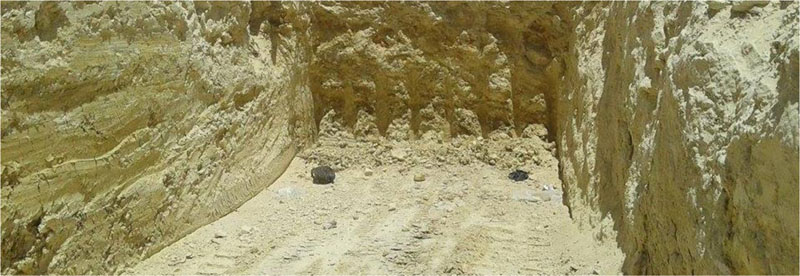 |
Fig. (1). Sampling Location (Trial Pit). |
The consolidation test was carried out to determine the compression index, swelling index, and other consolidation parameters. All testing procedures were carried out according to ASTM standards. Undisturbed clay samples were prepared and used to determine the unconfined compressive strength of all samples using Wykeham Farrance/Model 10050. Consolidation tests were carried out using Wykeham Farrance/Model 24000. X-ray diffraction was used to determine the mineralogy of the samples at the University of Jordan using the Cu-Kα radiation diffractometer system (Philips PW 1840) with a scan range of 2 to 60 °2θ.
3. RESULTS
3.1. X-Ray Diffraction
X-Ray Diffraction technique is used to analyze the mineralogical composition of the clay samples. It is well observed that all the analysis patterns are identical, which illustrates the representative oriented X-ray patterns of the separated clay fraction, air-dried (Fig. 2), and heated at 550˚C for two hours (Fig. 2). The XRD results of the clay size fraction have confirmed the presence of the expansive clay mineral Smectite as the major clay mineral together with kaolinite. The first (001) basal reflection appears at 15.5A˚ (Fig. 2a) and shifts to 17A˚ upon glycolation (Fig. 2b). The basal reflection (001) of the Glyconated samples is sharp. All other integral basal reflections are also present. The basal reflection (17A˚) collapses to 10A˚ upon heating at 550˚C for two hours (Fig. 2c). Kaolinite is detected together with smectite. The basal reflections (001 and 002) that appear at 7 A˚ and 3.5 A˚ disappear upon heating to 550˚C for two hours (Fig. 2c). Tables 1 and 2 show the major oxides of green clay and engineering properties of the selected clay samples, respectively.
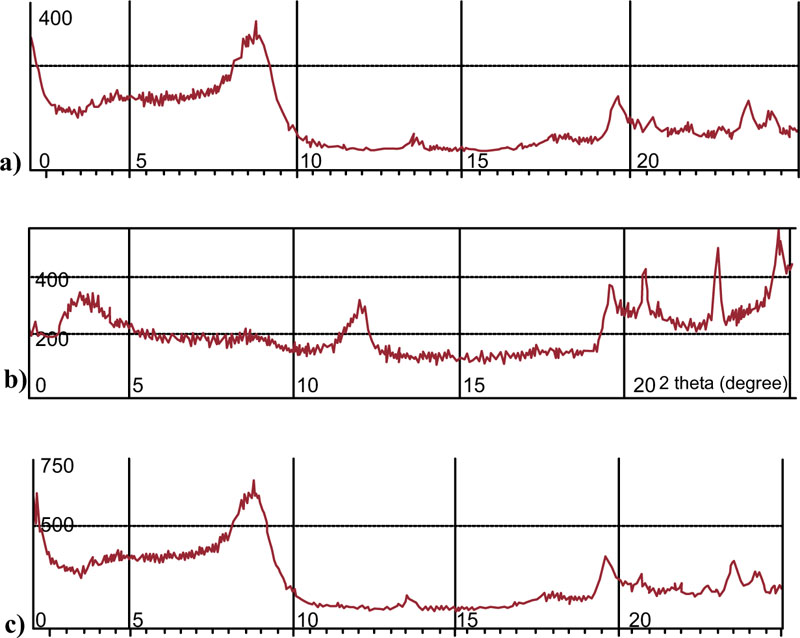 |
Fig. (2). (a) XRD –marly clay-Normal (b) XRD –marly clay- glycolated (c) XRD –marly clay- heated. |
| Sample No. | Liquid Limit (%) | Plastic Limit (%) | Shrinkage Limit (%) | Liquidity Index | Passing 200 Sieve (%) | Activity |
|---|---|---|---|---|---|---|
| C1 | 73 | 33 | 13 | -0.125 | 92.4 | 1.33 |
| C2 | 72 | 33 | 14 | -0.154 | 91.6 | 1.42 |
| C3 | 75 | 34 | 12 | -0.122 | 90.9 | 1.30 |
| C4 | 76 | 34 | 13 | -0.119 | 92.01 | 1.36 |
| C5 | 78 | 35 | 11 | -0.116 | 90.8 | 1.40 |
| C6 | 76 | 33 | 12 | -0.140 | 91.2 | 1.44 |
| Sample No. | Specific Gravity (Gs) | Natural Moisture Content (%) |
Natural Bulk Unit Weight kg / m3 |
Saturated Void Ratio (e max) |
γ dry Kg/m3 |
Saturated Moisture Content (%) |
Saturated Unit Weight Kg/m3 |
|---|---|---|---|---|---|---|---|
| C1 | 2.74 | 28 | 1759 | 0.95 | 1373 | 35.14 | 1856 |
| C2 | 2.75 | 27 | 1741 | 0.94 | 1371 | 35.0 | 1852 |
| C3 | 2.75 | 29 | 1774 | 0.93 | 1374 | 34.72 | 1851 |
| C4 | 2.73 | 29 | 1769 | 0.93 | 1372 | 34.8 | 1850 |
| C5 | 2.74 | 30 | 1781 | 0.94 | 1351 | 35.75 | 1835 |
| C6 | 2.74 | 27 | 1744 | 0.94 | 1375 | 34.9 | 1855 |
3.2. Sieve Analysis
Sieve analysis and hydrometer analysis of a typical green clay sample were conducted according to ASTM D 422 / ASTM D 1140. Fig. (3) shows that the clay fraction is around 37%, 50% silt, and little amount of sand. It can be classified as (CH) based on the Unified Soil Classification System (USCS).
3.3. Consolidation Test
The standard test method for one-dimensional consolidation (ASTM D2435) was conducted in order to understand the consolidation behaviour of the green clay. The results show that the clay was subjected to a pre-consolidation pressure of about 1.0 kg/cm2 with an over consolidation ratio OCR of about 6 (Fig. 4). It also shows a stiff response and little water absorption in the unloading-loading curve because of the pre-consolidation history and low clay fraction in the samples. This also demonstrates that green clay may lose its stiffness over many wet cycles. As can be seen from the consolidation test, it shows little change in the void ratio in the unloading part of the curve, which explains the stiffness of the green clay.
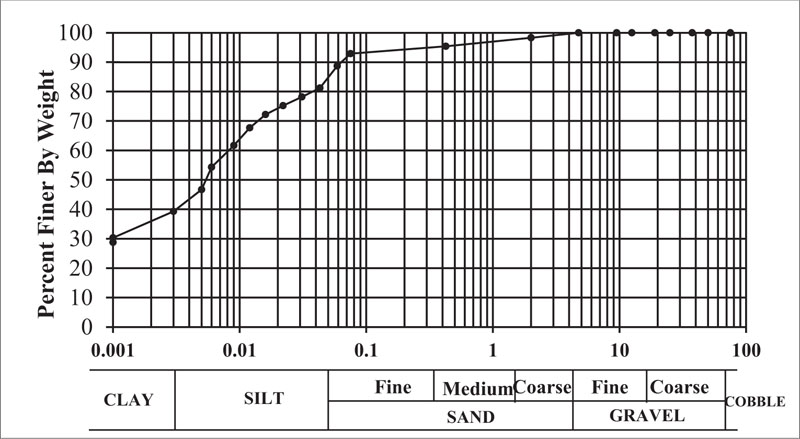 |
Fig. (3). Particle size distribution curve of green clay sample. |
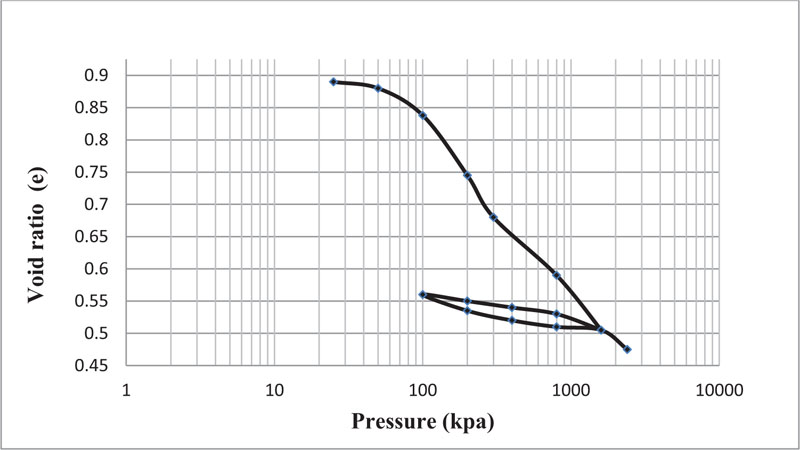 |
Fig. (4). Typical Consolidation test of Green clay sample. |
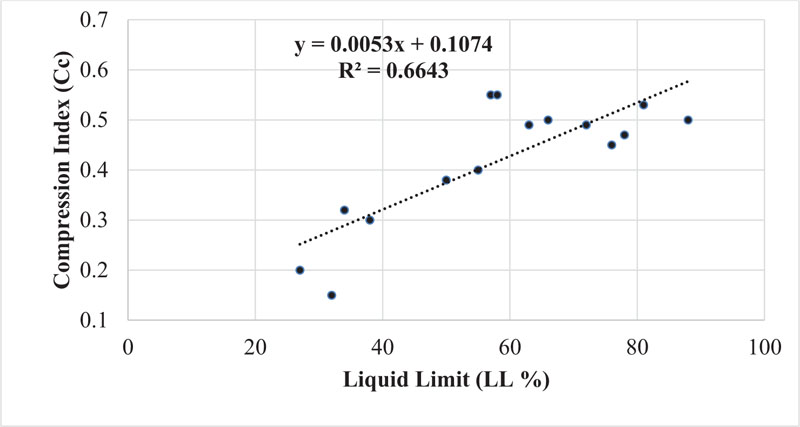 |
Fig. (5). Correlation between compression index (Cc) and liquid limit. |
Fig. (5) shows the relationship between the compression index Cc and the liquid limit of all samples. The findings of regression analysis based on the least square fit method of the given points indicate that there is a good correlation with the R-squared value of 0.664 though it does not comply with values obtained by the Skempton equation. This might be reasonably consistent with the correlation of other researchers described previously though the reason might be due to the nature of the clay tested and the presence of limestone within the sample. The presence of the limestone in the sample induces a strength gain by the pozzolanic reaction, which yields calcium silicate hydrates and calcium aluminate hydrates as the calcium from the lime reacts with the aluminates and silicates of the clay.
Fig. (6) also shows the correlation between the initial moisture content and the compression index (Cc). It shows a good correlation with an R2=0.77, and these values are around the average values obtained. This result is consistent with some empirical formulas that clearly show that the compression index is proportional to the moisture content.
Fig. (7) shows the relationship between the swelling index (Cs) and compression index (Cc), it exhibits a poor correlation when compared with other formulas used for its calculations. This can be explained by the nature of the green clay and its mineral structure and the pre-consolidation history, which added some cementitious properties to the green clay.
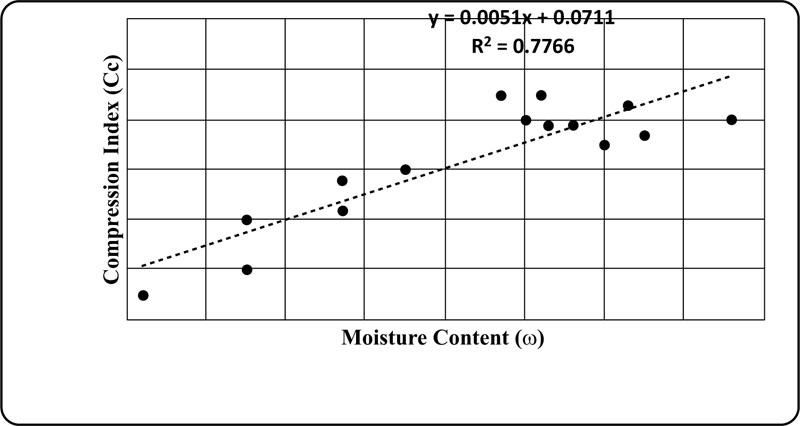 |
Fig. (6). Correlation between compression index (Cc) and moisture content. |
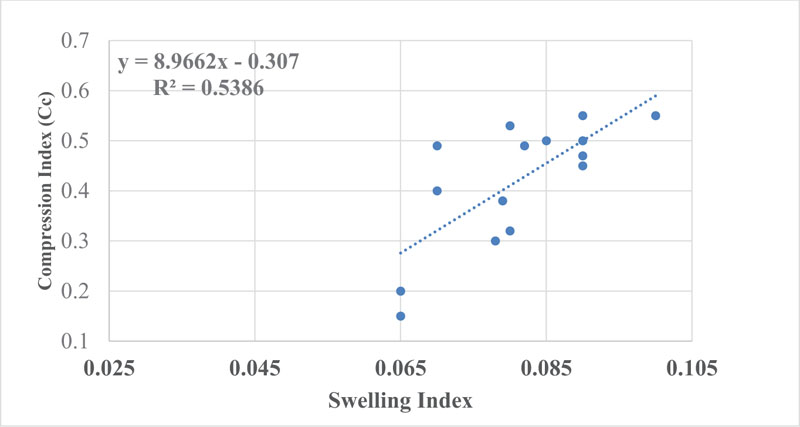 |
Fig. (7). Correlation between compression index (Cc) and swelling index (Cs). |
Fig. (8) shows the correlation between the compression index (Cc) and the initial void ratio of all the tested samples. It shows a good correlation in which the compressibility is proportional to the initial void ratio.
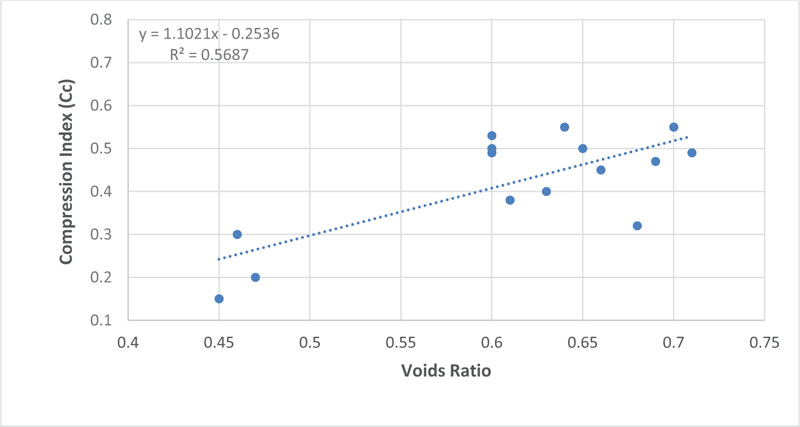 |
Fig. (8). Correlation between compression index (Cc) and initial void ratio. |
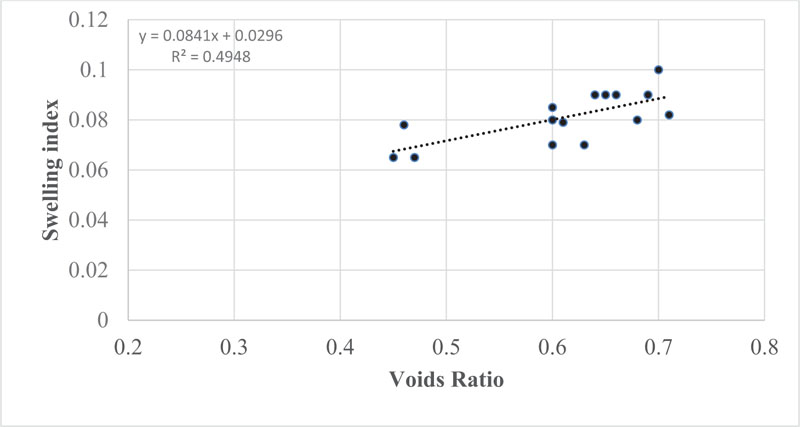 |
Fig. (9). Correlation between the swelling index and initial void ratio. |
In Fig. (9), the swelling index and void ratio show a weak correlation, and this reflects the obtained relationship between the compression index and the swelling index, as shown in Fig. (9).
3.4. Shear Strength Parameters of Green Clay
To evaluate the shear strength parameters of the green clay, two tests were carried out, namely an undrained strain-controlled direct shear test and the unconfined compression test. Fig. (10) shows the relationship between shear stress and horizontal shear displacement. It shows that the shear stress is too low at low vertical stress with a maximum value of shear stress of about 1.05 kg/cm2 and an internal angle of friction of about 18° along with the cohesion of 0.20 kg/cm2. The comparative analysis of the following results with the findings obtained by the unconfined compression test shows identical results with a margin of error of less than 3% (Fig. 11).
3.5. Unconfined Compression Test
A random sample out of 15 samples was obtained from a shallow depth of about 2 m (Fig. 12). As already mentioned above, this sample has an Over Consolidation Ratio (OCR) of about 6, and the pressure applied to the sample started from a value above, then that of over-consolidation pressure. However, the results are identical to those obtained from the direct shear test. These undisturbed samples were taken and tested during the dry season at a high over consolidation ratio and gave a high value of the unconfined compressive strength. This means that the green clay has gone far beyond some other clays due to its strength gain with time in the presence of limestone that helps in creating some cementitious properties. However, care must be taken in understanding these results, especially when tested in wet seasons.
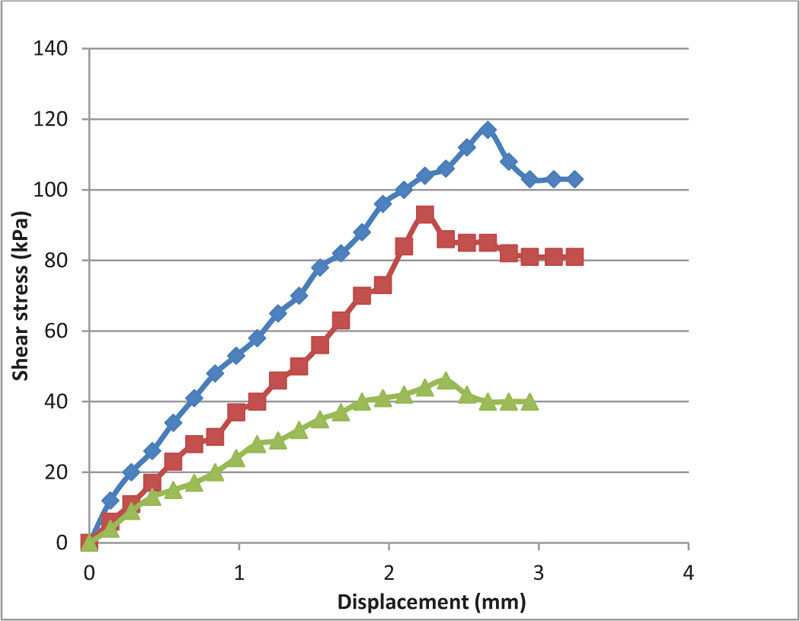 |
Fig. (10). Shear stress versus shear horizontal displacement. |
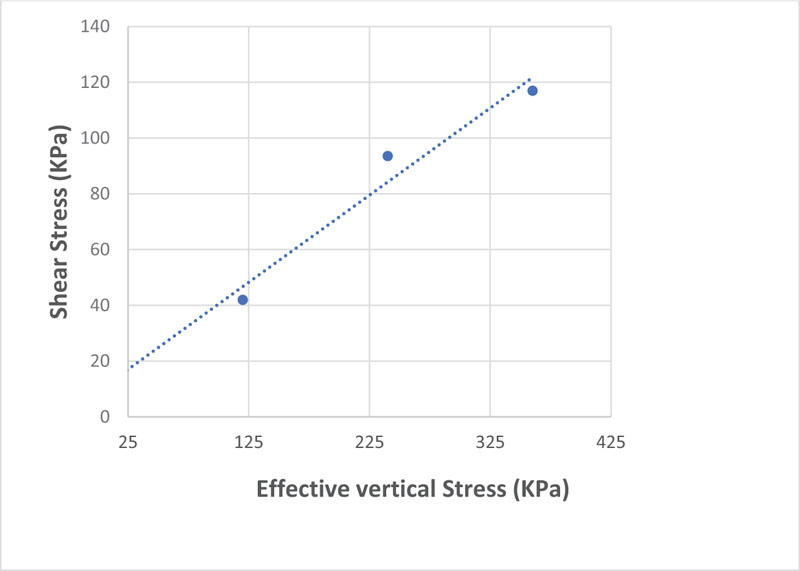 |
Fig. (11). Direct shear results of green clay. |
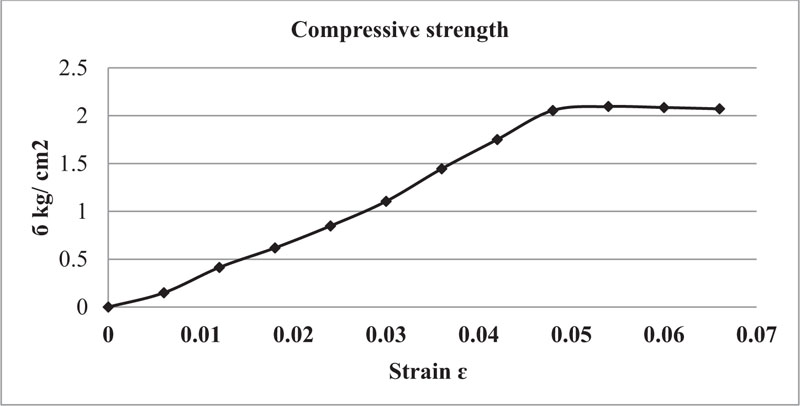 |
Fig. (12). Results of the unconfined compression test. |
4. DISCUSSION
High Swelling Green Clay belongs to the A7-6 group based on the Highway Research Board’s (HRB) classification of American soils based on particle size analysis and Atterberg limits, corresponding to the clayey soils. Furthermore, the clay is graded as a mineral clay of high plasticity on the Casagrande plasticity abacus. The study’s findings indicate that green clay mechanical properties are very poor. Both of these findings indicate that the geotechnical characteristics of the high swelling green clay, which will be used in road construction, need to be improved [22].
The formation of crystalline swelling and osmotic swelling, which are correlated with the hydration of inter-layer and interparticle pore spaces, respectively, is associated with the occurrence of swelling of expansive minerals, as shown by previous studies [23-28]. The crystalline swelling in Na-dominated bentonites that will widen the basal spacing to accommodate up to four layers of water molecules, while the osmotic swelling is primarily due to the forming of electrical diffuse double-layers [24]. As the adsorbed interlayer water is more than two, these swelling mechanisms can cause a substantial breakdown of the clay particles, which are made up of hundreds of stacked unit layers [25, 26]. As shown by Saiyouri et al. [27], it appears impossible to fully distinguish two swelling processes since they can coexist. The relative value of one over the other is heavily dependent on hydration levels. In the case of gradual swelling, for example, the crystalline swelling continues to form completely at high suction, accompanied by the occurrence of osmotic swelling at low suction. Water adsorption appears to occur in stages, beginning at the interlayer level and then progressing to the interparticle level. However, if the sample is inundated, osmotic swelling at the aggregate boundaries can initiate water ingress, resulting in a rapid increase in swelling strain during the primary swelling process. Following this, crystalline swelling occurs as a result of water diffusion from the inter-aggregate to intra-aggregate pore space, which is essential in the secondary swelling phase [28]. The disparity in the swelling strain rate during the secondary swelling process may be explained by the various swelling processes involved in the two forms of swelling experiments. For example, gradual swelling is likely to cause more significant clay particle breakdown and, as a result, a rise in exposed water adsorption surface sites. This could amplify the swelling that happens during the secondary swelling process.
CONCLUSION
The green clay undergoes volume changes and heaves upon wetting and drying. Based on the flocculation of water content, the clay then expands and shrinks. Apparently, the green clay contains a considerable amount of weathered clay minerals, such as smectite and illite. Since it is classified as a highly expansive clay, the weight of structures must be heavy enough to decrease the effect of heave and cracks if the foundation is needed to be built inside the water flocculation zone. In another case, where light structures prevail, it is recommended that the foundation system should be built below the water flocculation zone, and a mat foundation must be adopted to minimize eccentricity and the differential settlement. Compression index (Cc) plays a major role in settlement prediction for engineering foundations. Values of Cc measured for many green clay samples show that the green clay possesses a unique behaviour when compared with other types of clay, and its compression index cannot always be calculated by the available empirical formulas. Results also show a strong correlation between the compression index (Cc) with the initial moisture content, liquid limit, and the void ratio of the green clay.
CONSENT FOR PUBLICATION
Not applicable.
AVAILABILITY OF DATA AND MATERIALS
The datasets used and analyzed during the current study are available from the corresponding author [I. K.] upon reasonable request.
FUNDING
None.
CONFLICT OF INTEREST
The authors declare no conflict of interest, financial or otherwise.
ACKNOWLEDGEMENTS
The author is very thankful to all the associated personnel in any reference that contributed to/for this research.







